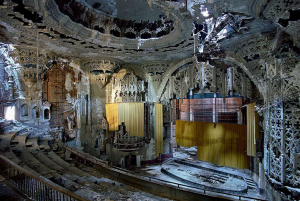Michigan Theater: Beat-up landmark or world’s most opulent parking lot?
Described in the press as “a jewel” and “the world’s finest” during its heyday, the fall of the Michigan Theater in Detriot is indicative of the city’s decline from a prosperous car manufacturing hub to a struggling economy. The derelict theater that once made headlines for its opulence and magnificence – and was built atop the site of Henry Ford’s first workshop – now functions as a three-level parking lot. There is some hope for it, though, as restoration plans by new owners promise to breathe life into its past glory.
Detroit’s new jewel
The Michigan Theater was built in 1925 at a time when automobile industry was at its peak. Designed in the French Renaissance style, the theater cost more than $3.5 million ($42.4 million today, when adjusted for inflation). With seating arrangements for up to 4,038 people, it was the only Detroit theater designed by renowned architects Cornelius W. and George L. Rapp.
Marble archways, staircase covered in lush red carpet, intricately carved furnishings, onyx pedestals adorned the interior, and a grand piano mesmerized and entertained guests waiting for the movie to start.
The Balaban & Katz group of Chicago in affiliation with Detroit’s first theater tycoon, John H. Kunsky, ran the theater. “It is not merely a theater for Detroit,” Kunsky told The Detroiter in August 1926. “It is a theater for the whole world. It is designed to be the great showplace of the Middle West.”
Modernity… and rock music fans
The rise of television and suburban theaters in the 60s lead to a dramatic drop in attendance at the theater, and the business turned unprofitable. In 1973, the theater was renamed the Michigan Palace and transformed into a 1,500-seat club, which failed miserably at drawing much of a crowd. Later, rock promoter Steven Glantz turned it into a concert venue, and several top rock artists of the 1970s like David Bowie, The Stooges, The New York Dolls, Aerosmith, Bob Seger, Rush, Iron Butterfly, Blue Oyster Cult and Badfinger performed there.
Unfortunately, concert goers left their mark on the building’s mirrors, chairs, tables, and brass. Four years on, the Michigan Palace was closed down after Bagley Associates Ltd. – the building’s owners – and Glantz fought over $175,000 in damage to the interior.
By this time, the building had fallen into such disrepair that in 1977, the owners paid $525,000 to gut the theater and build a three-level, 160-space parking deck inside it to cater to occupants in the adjoining office building. “When it’s all said and done, it just makes a hell of a lot more sense to tear it down than to try to fix it up again,” an unnamed Michigan Palace worker told the Free Press. “What we’re actually looking at is the end of an era.”
The mezzanine, balcony, the grand staircase, and one wall of the grand lobby were knocked down to suit the new role that the theater now donned. An antique company in California bought the rights to the décor and chandeliers, light fixtures, sinks, hand railings, etc were stripped off the walls and roofs.

Now: The screen from the balcony. Image by: denverpost.com (recent photo)
This time capsule still stands because tearing down the place would harm the adjacent building. Even today, the remnants of the splendor— the ticket booth, four-story lobby, proscenium arch, part of the upper balcony, even the red curtain—stand partially intact.
In July of this year, developers at the Boydell Group bought the Michigan Theater for an undisclosed amount. The company hopes to revive a part of the space and use it for events. A few days back, the Michigan Theater parking lot was converted into a temporary skate park for national skateboarding competitions.
Many of the city’s former industries and residences now lie abandoned resulting in several pockets of urban wasteland, especially in downtown Detroit. Other architectural wonders like the Michigan Central Station, Lee Plaza Hotel, the East Methodist Church, the Vanity Ballroom, Packard Motors Plant, and a number of 19th century Victorian houses are now in ruins and have a bleak future, unlike the Michigan Theater.
Recently, luxury goods and tech companies have been eyeing Detroit for its old-world charm and authenticity, bringing new hope to the city. What remains unanswered is how successful these global brands will be in restoring Motown’s heritage.
Related Posts
Category: Miscellaneous, News

















